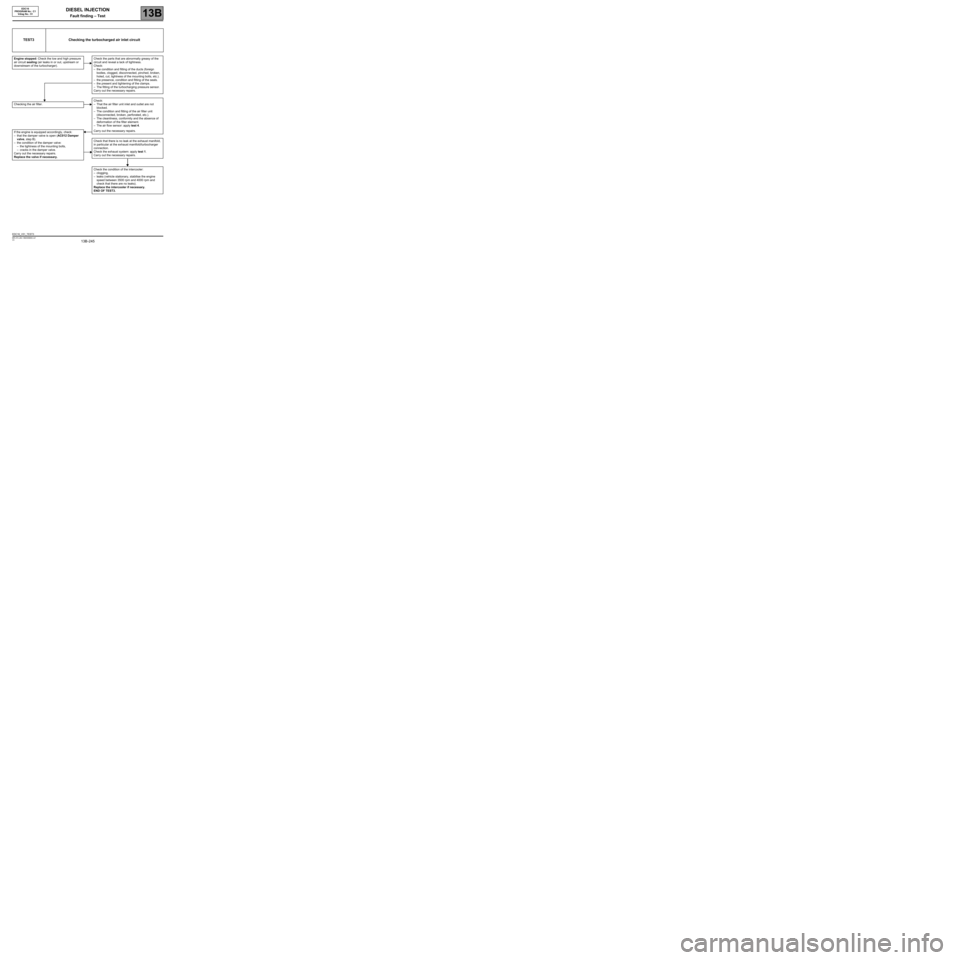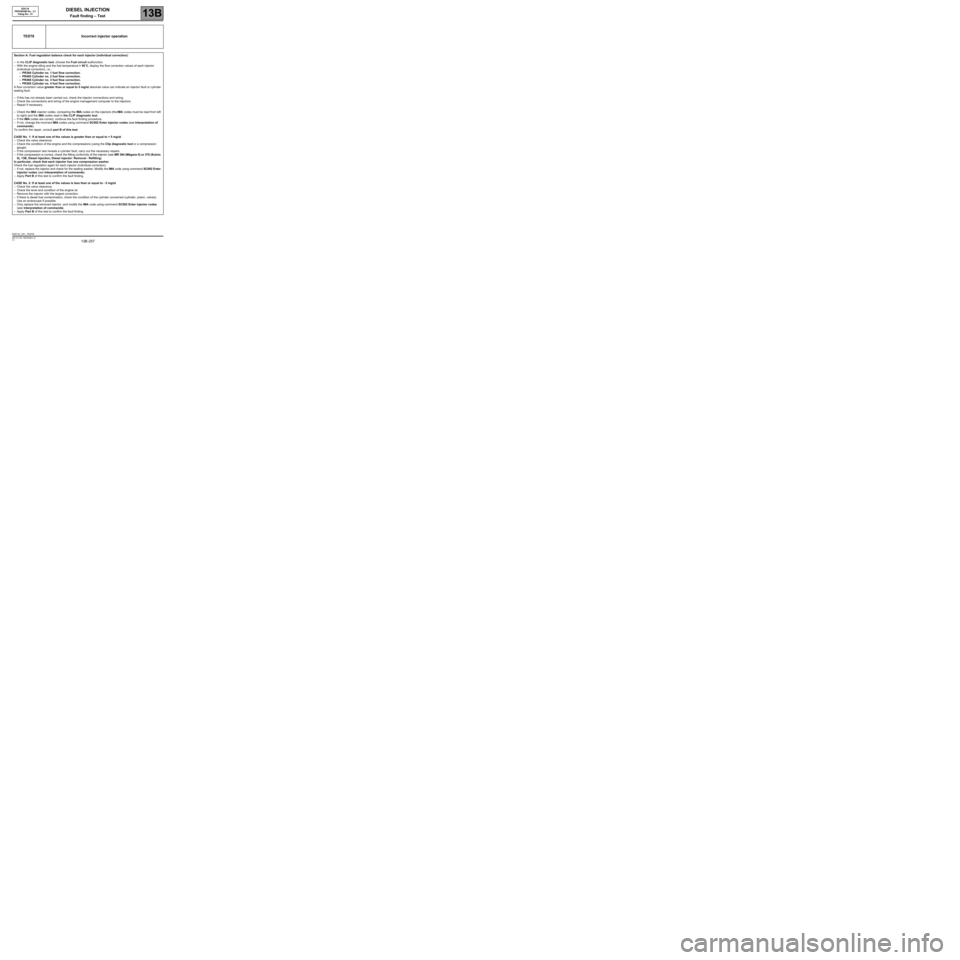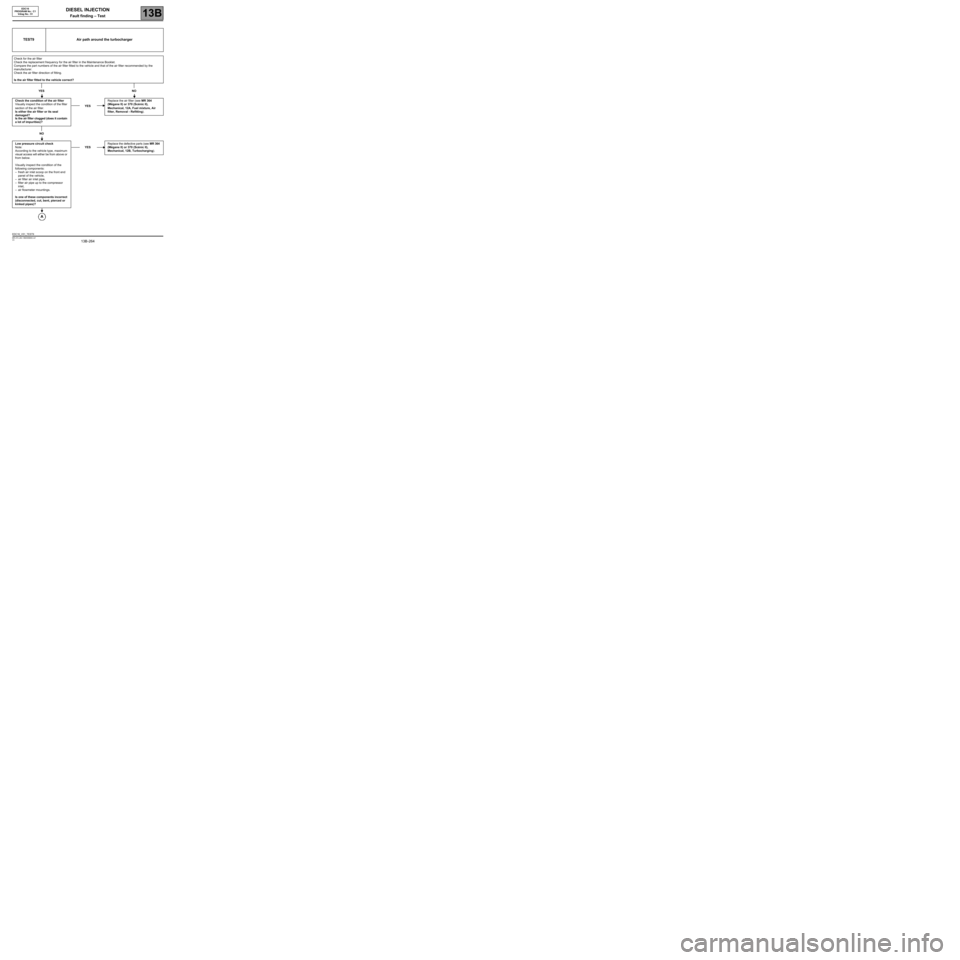2009 RENAULT SCENIC air condition
[x] Cancel search: air conditionPage 233 of 273

DIESEL INJECTION
Fault finding – Fault Finding Chart13B
13B -233V3 MR-372-J84-13B250$855.mif
EDC16
PROGRAM No.: C1
Vdiag No.: 51
ALP7 Rough idle
NOTESBefore dealing with this customer complaint, check that there are no faults, and
the conformity (or otherwise) of the parameters and statuses using the
diagnostic tool.
If the customer complaint is not eliminated, perform the following checks.
Check the sealing and condition of the inlet circuit: apply test 3 Turbocharged air circuit check.
Check the low pressure circuit: apply test 2 Low pressure circuit check.
check the engine parameters:
–check the update of the engine management computer calibration (last calibration).
–Check the conformity of the IMA codes (using the Identification screen on the Clip diagnostic tool).
–Check the charging circuit (see Technical Note 6014A Checking the charging circuit)
–To ensure the conformity of the engine speed signal, check:
●The wiring.
●The flywheel position and the condition of the flywheel teeth.
●The position and tightness of the engine speed sensor.
–Check the fuel flow correction from station to station: apply Test 8 Incorrect injector operation.
AFTER REPAIRcarry out a road test followed by a complete check with the diagnostic tool.
EDC16_V51_ALP7
Page 235 of 273

DIESEL INJECTION
Fault finding – Fault Finding Chart13B
13B -235V3 MR-372-J84-13B250$855.mif
ALP8 Oil leaks from the turbocharger
NOTESBefore dealing with this customer complaint, check that there are no faults, and
the conformity (or otherwise) of the parameters and statuses using the
diagnostic tool.
If the customer complaint is not ironed out, perform the following checks:
Check the area around the turbocharger
Note:
An oil leak does not correspond always to a turbocharger fault, the oil leak can arise from the area around the
turbocharger.
According to the vehicle type, maximum visual access will either be from above or from below.
1Do not start the engine.
Check the area around the turbocharger and identify the origin of the leaks.
Clean the oil traces on the turbocharger.
2start the engine and let it warm up for several minutes.
IMPORTANT
If the air filter was removed previously, refit it before starting the engine (risks foreign matter entering the air inlet
circuit).
Accelerate with no load several times, progressively increasing the duration before releasing the accelerator pedal.
Visually inspect the exterior condition of the fuel supply pipes and the turbocharger oil return and the area around it.
Identify the origin of the leaks.
Is an oil leak present at the air compressor inlet or outlet?
YESNO
Check the air compressor inlet or outlet
Check for a loose interface (inlet or outlet) that is the cause of the air leak.
Note:
it is normal to find traces of oil inside the pipes at the turbocharger inlet or outlet as the air
passing into the compressor is laden with oil from the engine rebreathing circuit.
Is the suspected interface properly tightened?
YES NO
Replace the pipe concerned (see MR
364 (Mégane II) or 370 (Scénic II),
Mechanical systems, 12B,
turbocharging).Tighten the interface or the concerned
pipe.
End of procedure.
AFTER REPAIRCarry out a road test followed by a complete check with the diagnostic tool.
EDC16
PROGRAM No.: C1
Vdiag No.: 51
EDC16_V51_ALP8
Page 243 of 273

DIESEL INJECTION
Fault finding – Test13B
13B -243V3 MR-372-J84-13B250$900.mif
EDC16
PROGRAM No.: C1
Vdiag No.: 51
TEST2 Low pressure circuit check
Check the fuel filter:
–Conformity of the fuel filter (correct part number and RENAULT filter).
–Positioning and amount of clogging in the filter element.
–Positioning and condition of the seals.
–If there is metal swarf in the filter:
Replace the fuel filter, bleed the circuit and continue the fault finding procedure.
Supplying the injection system with fuel from an additional tank.
This operation aims to detect possible faults in the low pressure supply system of a vehicle by replacing it entirely
with an additional tank.
Mode:
–Disconnect the diesel fuel supply pipe at the fuel filter inlet and seal it with a plug.
–Connect a pipe to the fuel filter inlet and insert the other end into a clean container which is approximately 5 litres
in volume.
–Disconnect the diesel fuel return pipe at the pump return and injector leak-off junction and seal it with a plug.
–Fill the container with clean diesel fuel.
–Start the engine and let the system drain itself of its air (there must not be any air bubbles in the return pipe).
Is the customer complaint still present?
NO
Are the low pressure circuit connections in order and
in good condition?
NO
Carry out the necessary repairs.
YESIf the low pressure circuit is in order,
reconnect the various pipes making up the
low pressure circuit and repeat the fault
finding procedure in the fault finding chart
or for the fault that referred you to this test.
YES
EDC16_V51_TEST2
Page 244 of 273

DIESEL INJECTION
Fault finding – Test13B
13B -244V3 MR-372-J84-13B250$900.mif
EDC16
PROGRAM No.: C1
Vdiag No.: 51
TEST2
CONTINUED
Check the condition of the priming bulb, and that it is working properly.
Perform repairs if necessary and continue the test.
If the fault is still present with a low fuel level, check the consistency of the actual fuel level and that indicated on
the instrument panel.
–The transfer pump is supplied via a venturi valve located beneath it.
Check that the opening of the venturi (6 to 8 mm in diameter) is not blocked by dirt contained in the fuel tank.
Check the priming of the low pressure diesel circuit.
Check the conformity of the fuel used by applying test 10 Diesel fuel conformity check.
If the diesel fuel is not correct:
–Replace the diesel fuel.
–Change the diesel filter.
–Bleed the low and high pressure diesel circuit.
Low pressure circuit correct.
END OF TEST2.
Page 245 of 273

DIESEL INJECTION
Fault finding – Test13B
13B -245V3 MR-372-J84-13B250$900.mif
Checking the air filter.
If the engine is equipped accordingly, check:
–that the damper valve is open (AC012 Damper
valve, step B).
–the condition of the damper valve:
–the tightness of the mounting bolts,
–cracks in the damper valve.
Carry out the necessary repairs.
Replace the valve if necessary.
EDC16
PROGRAM No.: C1
Vdiag No.: 51
TEST3 Checking the turbocharged air inlet circuit
Engine stopped: Check the low and high pressure
air circuit sealing (air leaks in or out, upstream or
downstream of the turbocharger).Check the parts that are abnormally greasy of the
circuit and reveal a lack of tightness.
Check:
–the condition and fitting of the ducts (foreign
bodies, clogged, disconnected, pinched, broken,
holed, cut, tightness of the mounting bolts, etc.).
–the presence, condition and fitting of the seals.
–the present and tightening of the clamps.
–The fitting of the turbocharging pressure sensor.
Carry out the necessary repairs.
Check:
–That the air filter unit inlet and outlet are not
blocked.
–The condition and fitting of the air filter unit
(disconnected, broken, perforated, etc.).
–The cleanliness, conformity and the absence of
deformation of the filter element.
–The air flow sensor: apply test 4.
Carry out the necessary repairs.
Check that there is no leak at the exhaust manifold,
in particular at the exhaust manifold/turbocharger
connection.
Check the exhaust system: apply test 1.
Carry out the necessary repairs.
Check the condition of the intercooler:
–clogging,
–leaks (vehicle stationary, stabilise the engine
speed between 3500 rpm and 4000 rpm and
check that there are no leaks).
Replace the intercooler if necessary.
END OF TEST3.
EDC16_V51_TEST3
Page 251 of 273

DIESEL INJECTION
Fault finding – Test13B
13B -251V3 MR-372-J84-13B250$900.mif
EDC16
PROGRAM No.: C1
Vdiag No.: 51
TEST5
CONTINUED 3
Check the vacuum at the solenoid valve inlet
Let the engine idle.
Disconnect the vacuum pipe from the solenoid valve inlet end piece.
This pipe connects the vacuum pump to the turbocharger solenoid valve.
Connect a vacuum pressure gauge to the end of the disconnected pipe and put it in the vacuum
measurement position.
Read the vacuum displayed by the pressure gauge.
Tolerance intervals to be respected for the vacuum value:
-1 bar < CORRECT vacuum value < -0.85 bar
-0.85 bar < INCORRECT vacuum value < 0 bar
Does the vacuum displayed at the solenoid valve inlet by the pressure gauge respect the tolerance
interval?
NO YES
Replace the solenoid valve (see MR 364 (Mégane
II) or 370 (Scénic II), Mechanical, 12B,
Turbocharging).
Carry out the following operations.
–reconnect the vacuum pipe to the turbocharger solenoid valve.
–Check the vacuum pipe or pipes are connected correctly.
–visually inspect the condition of the vacuum pipes from the vacuum pump to the various components supplied.
Refer to the repair manual (see MR 364 (Mégane II) or 370 (Scénic II), Mechanical, 12B Turbocharging).
C
1
Page 257 of 273

DIESEL INJECTION
Fault finding – Test13B
13B -257V3 MR-372-J84-13B250$900.mif
EDC16
PROGRAM No.: C1
Vdiag No.: 51
TEST8 Incorrect injector operation
Section A: Fuel regulation balance check for each injector (individual correction):
–In the CLIP diagnostic tool, choose the Fuel circuit subfunction.
–With the engine idling and the fuel temperature > 50˚C, display the flow correction values of each injector
(individual correction), i.e.:
–PR364 Cylinder no. 1 fuel flow correction.
–PR405 Cylinder no. 2 fuel flow correction.
–PR406 Cylinder no. 3 fuel flow correction.
–PR365 Cylinder no. 4 fuel flow correction.
A flow correction value greater than or equal to 5 mg/st absolute value can indicate an injector fault or cylinder
sealing fault.
–If this has not already been carried out, check the injector connections and wiring.
–Check the connections and wiring of the engine management computer to the injectors.
–Repair if necessary.
–Check the IMA injector codes, comparing the IMA codes on the injectors (the IMA codes must be read from left
to right) and the IMA codes read in the CLIP diagnostic tool.
–If the IMA codes are correct, continue the fault finding procedure,
–If not, change the incorrect IMA codes using command SC002 Enter injector codes (see Interpretation of
commands).
To confirm the repair, consult part B of this test.
CASE No. 1: If at least one of the values is greater than or equal to + 5 mg/st
–Check the valve clearance.
–Check the condition of the engine and the compressions (using the Clip diagnostic tool or a compression
gauge).
–If the compression test reveals a cylinder fault, carry out the necessary repairs.
–If the compression is correct, check the fitting conformity of the injector (see MR 364 (Mégane II) or 370 (Scénic
II), 13B, Diesel injection, Diesel injector: Removal - Refitting)
In particular, check that each injector has one compression washer.
Check the fuel regulation again for each injector (individual correction).
–If not, replace the injector and check for the sealing washer. Modify the IMA code using command SC002 Enter
injector codes (see Interpretation of commands).
–Apply Part B of this test to confirm the fault finding.
CASE No. 2: If at least one of the values is less than or equal to - 5 mg/st
–Check the valve clearance.
–Check the level and condition of the engine oil.
–Remove the injector with the largest correction.
–If there is diesel fuel contamination, check the condition of the cylinder concerned (cylinder, piston, valves).
Use an endoscope if possible.
–Only replace the removed injector, and modify the IMA code using command SC002 Enter injector codes
(see Interpretation of commands).
–Apply Part B of this test to confirm the fault finding.
EDC16_V51_TEST8
Page 264 of 273

DIESEL INJECTION
Fault finding – Test13B
13B -264V3 MR-372-J84-13B250$900.mif
TEST9 Air path around the turbocharger
Check for the air filter
Check the replacement frequency for the air filter in the Maintenance Booklet.
Compare the part numbers of the air filter fitted to the vehicle and that of the air filter recommended by the
manufacturer.
Check the air filter direction of fitting.
Is the air filter fitted to the vehicle correct?
YES NO
Check the condition of the air filter
Visually inspect the condition of the filter
section of the air filter.
Is either the air filter or its seal
damaged?
Is the air filter clogged (does it contain
a lot of impurities)?YESReplace the air filter (see MR 364
(Mégane II) or 370 (Scénic II),
Mechanical, 12A, Fuel mixture, Air
filter, Removal - Refitting).
NO
Low pressure circuit check
Note:
According to the vehicle type, maximum
visual access will either be from above or
from below.
Visually inspect the condition of the
following components:
–fresh air inlet scoop on the front end
panel of the vehicle,
–air filter air inlet pipe,
–filter air pipe up to the compressor
inlet,
–air flowmeter mountings.
Is one of these components incorrect
(disconnected, cut, bent, pierced or
kinked pipes)?YESReplace the defective parts (see MR 364
(Mégane II) or 370 (Scénic II),
Mechanical, 12B, Turbocharging).
EDC16
PROGRAM No.: C1
Vdiag No.: 51
EDC16_V51_TEST9